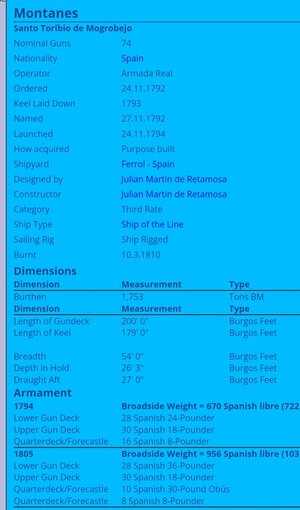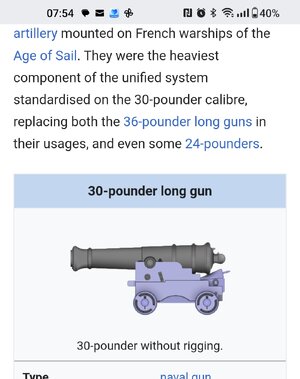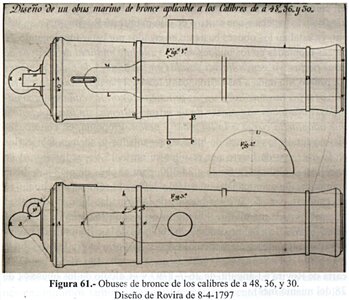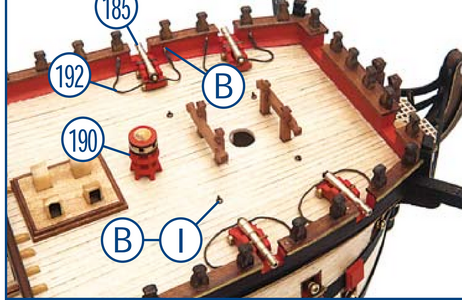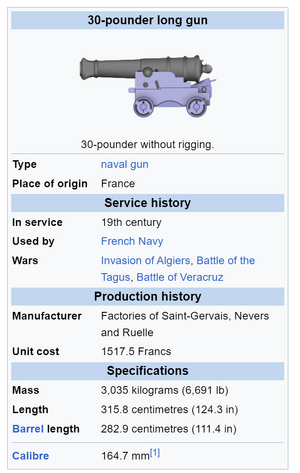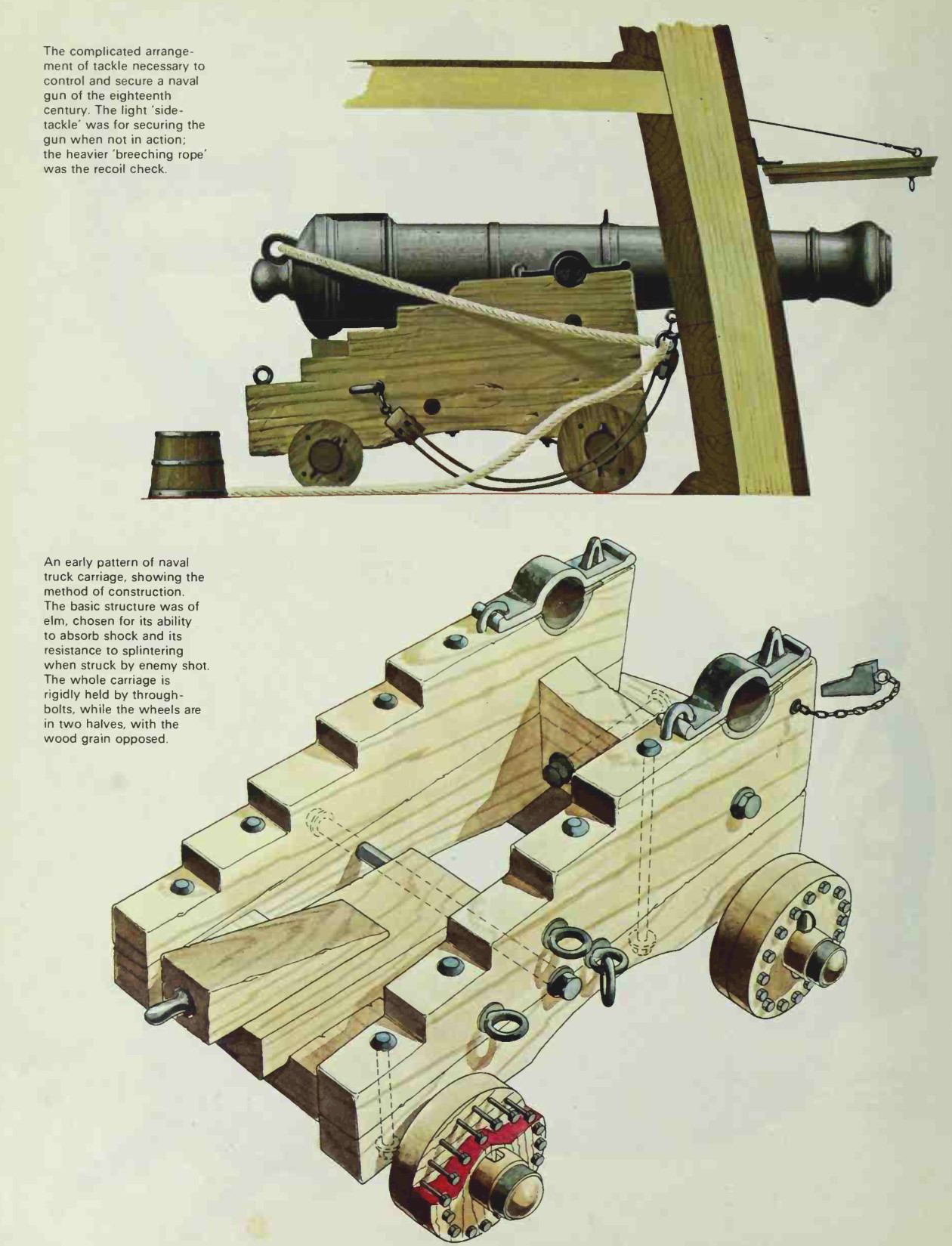Spanish Artillery (1745-1808)
Stephen Summerfield of Loughborough University
and an intzeresting posting
The naval howitzer or mortar was use to thrown “bombs” exploding shell in a high arc — usually from vessels into shore fortifications, but also from ship to ship, and from shore to ship. The word was rendered into German as aufeniz as early as 1440; later in Italian obice, Portuguese obus, French obusier, Spanish obús, and the
Dutch word houwitser, which may have led led to the English word howitzer. In my opinion the obús was more of a mortar than a true howitzer, which was predominately a field artillery weapon.
Well into the 16th century, mortar trajectory was reasoned to be most effective at an elevation of 45 degrees, and mortars were often cast as a single piece with an integrated bed fixed at that angle. This meant that mortars had to be moved or fitted with blocks and wedges to vary the trajectory when 45 degrees was found to be inadequate. A medium-sized mortar with a high angle of fire, filled with a burlap bag of small shot balls known as grapeshot, could be positioned close to the rail of the vessel and aimed at a near-vertical angle to rain down destruction on enemy skiffs or ships approaching close enough for boarding.
Meet the Mortar: A Deadly 600-Year-Old Weapon
The key difference between a naval gun and a naval howitzer is the maximum elevation (depression for purists) angle for a Gun is 45 degrees, whereas for a Howitzer or mortar it is greater than that and enables the trajectory to go a lot higher. Physically, the howitzer resembled the mortar in length and general design, with the major difference being that the trunnions (the outcroppings on the barrel which fixed the weapon to its carriage) were located at the midpoint of the barrel, rather than at the rear like the mortar. In many ways, this weapon was something of a cross between a cannon and a mortar.


Naval mortar innovations continued to develop. In the late 17th century, small single-masted ships devoted to handling large mortars became highly effective in naval bombardments. Called simply mortar ships (or bomb vessels), these carried a combined gun and ship crew of eight and a complement of two huge mortars on massive turntable supports and embedded in a ball-and-socket base for aiming. Mortar ships were ideal for bombarding fortifications or strongpoints on high bluffs and cliffs, especially if they were able to maneuver close enough to shore to be protected from the forts’ guns, with their limited angles of fire.

Artist’s concept of an early obús / howitzer used as a shore defense. The commissioner general of artillery, Francisco Javier Rovira, initially installed light obús pieces to launch grenades (bombs) with both direct fire and with high arcing fire (suggesting a howitzer-like weapon). The proof of the usefulness these weapons being established, in 1785 the naval board introduced modifications to them [the shells? the weapons?].
Historia del navío de línea Santa Ana (2) See below*
Base mortars were generally shorter-barrelled weapons, usually fixed in a wooden "bed" at a 45-degree angle. The inside of a mortar was double chambered. In other words, there was a large chamber for the projectile and a smaller one at the rear of the tube for the gunpowder charge. Rather than firing a solid ball like the cannon, mortars fired exploding projectiles called "bombs." A typical “bomb” resembled a solid cannonball, but was hollow and filled with gunpowder. Just prior to firing, a wooden fuse was placed in a hole in the bomb after being cut to the proper length by one of the gunners. The the gunner would light the bomb fuse, followed by the gun )hopefully), and when bomb fuse burnt into the bomb, the powder inside would explode, sending large fragments of the bomb out in various directions. Explosive shells could be lobbed into targets from 50 to 1,200 yards away.
On land, a portable mortar named the Coehorn after its inventor, Dutch military engineer Baron van Menno Coehoorn, appeared in 1673. In the mid-19th century, the small portable Coehorn found ready use along with larger mortars during the American Civil War. By the end of the century, however, concerted military opinion in European countries such as Great Britain held that mortars were obsolete alongside the great advances in cannon technology. However, after trench warfare became quite common, mortars were found again to be increasingly useful.
*En 1785 se adquirieron seis carronadas de gran calibre a la fábrica escocesa de Carron, 2 eran de calibre 96, 2 de 68 y dos más de calibre 42, con sus montajes, pertrechos y municiones al completo, que fueron probadas comparativamente con unos obuses marinos proyectados por el comisario General de Artillería Francisco Javier Rovira, piezas ligeras para lanzar granadas con tiro directo y aumentar los fuegos altos de los buques. Las pruebas fueron realizadas en 1785 a bordo del navío "Santa Ana" y sus resultados dieron lugar a que se introdujeran modificaciones en los obuses.
Answer (1 of 2): Thanks for the A2A Shortish Answer * Like carronades, howitzers were short-barrelled, light-weight weapons designed to fire with lower propellant charges. * In contrast to the carronade, the howitzer is designed to fire common shell (aka grenado) - a fuzed exploding projectil...

www.quora.com

